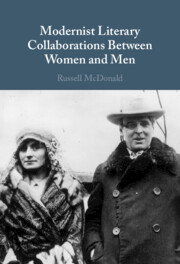Book contents
- Modernist Literary Collaborations Between Women and Men
- Modernist Literary Collaborations Between Women and Men
- Copyright page
- Dedication
- Contents
- Figures
- Acknowledgments
- Abbreviations
- Introduction
- Chapter 1 Imagining Two as One: Collaboration and the Discourse of Sex Relations in Early Modernism
- Chapter 2 The Discord Aesthetic in D. H. Lawrence’s Collaborations with Women
- Chapter 3 “The Fight to Be Affectionate”: Textual Intimacy and the Drive to Animate Marriage
- Chapter 4 “The Yolk and White of the One Shell”: Modernism’s Androgynous Textual Bodies
- Chapter 5 Conclusion: Being a Genius Together
- Notes
- Works Cited
- Index
Introduction
Published online by Cambridge University Press: 20 October 2022
- Modernist Literary Collaborations Between Women and Men
- Modernist Literary Collaborations Between Women and Men
- Copyright page
- Dedication
- Contents
- Figures
- Acknowledgments
- Abbreviations
- Introduction
- Chapter 1 Imagining Two as One: Collaboration and the Discourse of Sex Relations in Early Modernism
- Chapter 2 The Discord Aesthetic in D. H. Lawrence’s Collaborations with Women
- Chapter 3 “The Fight to Be Affectionate”: Textual Intimacy and the Drive to Animate Marriage
- Chapter 4 “The Yolk and White of the One Shell”: Modernism’s Androgynous Textual Bodies
- Chapter 5 Conclusion: Being a Genius Together
- Notes
- Works Cited
- Index
Summary
The introduction opens with a reading of a passage from a 1914 letter by D. H. Lawrence to establish three major facets of the book’s argument: (1) for many modernists, cross-sex collaboration offered a practical way of using gender difference as a source of creative energy; (2) both Lawrence and many of his contemporaries viewed shared creative activity between women and men as deeply and positively subversive; and (3) rather than envisioning cross-sex collaboration as a harmonious synthesis of opposites, Lawrence revels in the prospect of its leading to unresolvable gender conflict. It then introduces my concept of the discord aesthetic, which refers to the modernists’ tendency to use conflict between the sexes as a creative catalyst and infuse the texts they made together with evidence of that conflict; situates my argument with respect to prior scholarship on the intersections between modernism, gender, and literary couplings; and acknowledges my debt to the textual scholarship methodology of reading the linguistic and material dimensions of texts as working together to create meaning.
Keywords
- Type
- Chapter
- Information
- Publisher: Cambridge University PressPrint publication year: 2022

